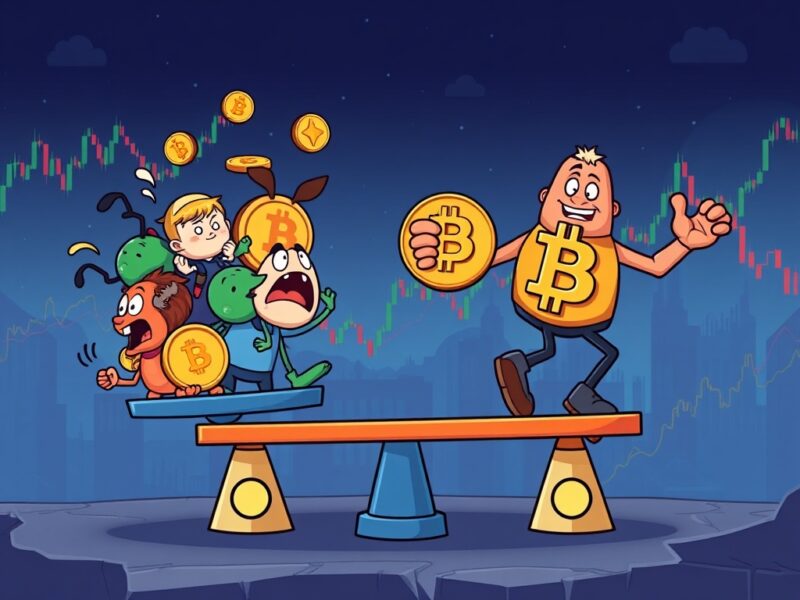Pivotal September Interest Rate Cut: Fed Governor Waller’s Bold Call
BitcoinWorld
Pivotal September Interest Rate Cut: Fed Governor Waller’s Bold Call
The prospect of a September interest rate cut has suddenly become a central talking point in financial circles, thanks to a surprising intervention from a key figure at the Federal Reserve. Federal Reserve Governor Christopher Waller, widely regarded as a significant voice within the central bank and even a potential future Fed chair, recently shared his views in a CNBC interview. His statement suggests a strong push for the central bank to reduce interest rates at its upcoming policy meeting in September, igniting considerable debate and speculation.
Why is a September Interest Rate Cut on the Table?
Waller’s comments are particularly noteworthy because they come from a prominent Fed official. He indicated that the central bank should consider easing its monetary policy sooner rather than later. This perspective contrasts with some of the more cautious stances often heard from other Fed members. Waller’s rationale likely stems from evolving economic data, particularly concerning inflation and employment figures, which might suggest that the economy is cooling enough to warrant a rate adjustment.
The Fed’s primary goals are to maintain maximum employment and stable prices. When inflation shows signs of being under control and the labor market remains robust but not overheated, there’s room to consider rate cuts. Such cuts typically aim to stimulate economic growth by making borrowing cheaper for businesses and consumers, encouraging investment and spending. This could have a ripple effect across various sectors, including the cryptocurrency market, which often reacts to broader economic sentiment and liquidity changes.
Key considerations driving this discussion include:
- Inflation Trends: Are inflation rates consistently moving towards the Fed’s 2% target?
- Employment Data: Is the job market showing signs of softening without significant job losses?
- Global Economic Health: How are international economic conditions influencing the US outlook?
What Could a September Interest Rate Cut Mean for Markets?
A potential September interest rate cut could trigger significant shifts across financial markets. Historically, lower interest rates tend to make riskier assets, like stocks and cryptocurrencies, more attractive. When bonds offer lower yields, investors often seek higher returns elsewhere, potentially flowing into digital assets. This increased liquidity and risk appetite could provide a boost to the crypto market, which has often shown sensitivity to macroeconomic policy shifts.
However, it’s not a guaranteed upward trajectory. Market reactions are complex and depend on the underlying reasons for the cut. If the cut is perceived as a response to a weakening economy, it might initially cause apprehension. Conversely, if it’s seen as a measured move to support a healthy economy, it could be a positive catalyst. Traders and investors will be closely watching the Fed’s official statements and economic projections for clearer signals.
Potential impacts include:
- Increased Liquidity: More money flowing into the system can seek out higher-yielding or riskier assets.
- Stronger Risk Appetite: Investors might be more willing to take on risk with cheaper borrowing costs.
- Dollar Weakness: Lower rates can weaken the dollar, making dollar-denominated assets, including some cryptocurrencies, more appealing to international investors.
Navigating the Future: What Should Investors Watch for Regarding the September Interest Rate Cut?
For investors, staying informed is paramount. The Fed’s policy meetings are critical events, and any statements from governors like Waller offer valuable insights. It’s crucial to monitor official Fed communications, including minutes from past meetings and upcoming speeches. Pay close attention to inflation reports, employment statistics, and consumer confidence surveys. These data points collectively paint a picture of the economic landscape that informs the Fed’s decisions regarding a September interest rate cut.
Moreover, consider diversifying your portfolio and understanding how different asset classes react to changes in monetary policy. While a rate cut can be beneficial for certain assets, a balanced approach is always wise. The cryptocurrency market, in particular, can be volatile, and external economic factors play a significant role in its movements. Understanding the potential implications of a rate cut allows you to make more informed decisions.
Actionable insights for investors:
- Stay Updated: Follow Fed announcements and economic data releases.
- Assess Risk Tolerance: Re-evaluate your portfolio’s risk exposure in light of potential policy shifts.
- Look Beyond the Headlines: Understand the ‘why’ behind any rate decision, not just the ‘what’.
Conclusion: The Path to a Potential September Interest Rate Cut
Federal Reserve Governor Christopher Waller’s recent advocacy for a September interest rate cut has undeniably shifted the conversation around the central bank’s future monetary policy. While his comments are a strong indicator, they do not guarantee a rate cut. The Fed operates on consensus, and its decisions are data-dependent. Nevertheless, Waller’s influential voice signals a growing consideration within the Fed to potentially ease monetary conditions. This development warrants close attention from anyone involved in financial markets, especially those in the dynamic cryptocurrency space, as it could usher in a new phase of economic activity and investment trends. The coming months will reveal whether Waller’s vision for a September cut becomes a reality, shaping the economic landscape for the foreseeable future.
Frequently Asked Questions (FAQs)
Q1: Who is Federal Reserve Governor Christopher Waller?
A1: Christopher Waller is a member of the Federal Reserve’s Board of Governors, appointed by the President. He is a highly influential voice within the central bank and is sometimes considered a potential candidate for the Fed chair position.
Q2: Why is a September interest rate cut being discussed now?
A2: The discussion around a September interest rate cut stems from evolving economic data, particularly signs that inflation may be moderating and the labor market, while strong, is not overheating. Fed officials like Governor Waller are assessing if these conditions warrant easing monetary policy to support economic growth.
Q3: How might a September interest rate cut affect the cryptocurrency market?
A3: A September interest rate cut could potentially increase liquidity in the financial system and encourage a stronger risk appetite among investors. This often makes riskier assets, including cryptocurrencies, more attractive compared to traditional assets, potentially leading to increased investment and price appreciation in the crypto market.
Q4: What factors does the Fed consider before cutting interest rates?
A4: The Federal Reserve considers a range of economic indicators, including inflation rates, employment data, wage growth, consumer spending, and global economic conditions. Their primary goals are to achieve maximum employment and maintain price stability (typically targeting 2% inflation).
Q5: Is a September interest rate cut guaranteed based on Waller’s comments?
A5: No, Governor Waller’s comments indicate a strong advocacy for a September interest rate cut, but they do not guarantee it. The Fed’s decisions are made by consensus among its members and are data-dependent, meaning they will react to the latest economic information leading up to the September meeting.
Did you find this analysis on the potential September interest rate cut insightful? Share this article with your network on social media to keep the conversation going and help others understand the potential impacts on the economy and financial markets!
To learn more about the latest crypto market trends, explore our article on key developments shaping the crypto market‘s price action.
This post Pivotal September Interest Rate Cut: Fed Governor Waller’s Bold Call first appeared on BitcoinWorld and is written by Editorial Team
También te puede interesar

Cardone Capital to acquire 3000 BTC in pivot to Bitcoin-backed real estate strategy

PA Daily | Tiger Securities launches BTC and ETH deposit and withdrawal services; Abraxas Capital purchased $561 million of ETH in the past week
